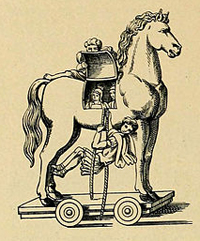New York Supreme Court Justice Joseph Farneti ruled that Jewish markers proposed for utility poles in Southampton would be “invisible” and rejected SH's bid to block them. Eruvim, once established, are commonly displayed on Synagogue websites.
The Hampton Synagogue, Westhampton Beach, which initiated the quest for the eruv boundaries in 2008, shows the outlines of an eruv on it website.
The much more elaborate Manhattan eruv is shown on a Google map.
No one thus far, including the Southampton Press, which examined 47 WHB poles licensed for the lechi markers, has been able to find any evidence of them. The eruv appears to exist only on the Synagogue’s website.
Eruv scholar Charlotte Fonrobert of Stanford University has argued that since eruvim are "readily accessible online," showing a Jewish community is laying claim to a geographical area of town," they can no longer be considered hidden or unobtrusive.
WHB Candidates Opposed Eruv
The East End Eruv Assn., which supposedly placed lechis on the poles under agreements with Verizon and Long Island Power, will not say where they are. EEEA said it fears vandalism to the markers if they are identified. Removal or damage to one lechi would invalidate the entire network.
Conrad Teller, mayor of WHB until last year, had estimated that 90-95% of local residents opposed the eruv. Further evidence of WHB sentiment on the eruv is that eruv opponents Brian Tymann and Rob Rubio, who challenged incumbents Hank Tucker and Patricia DiBenedetto for WHB board seats June 19, won election by a large margin—248 and 240 votes, respectively, to 161 and 142 votes for Tucker/DiBenedetto, who were silent on the issue.
Tyman and Rubio had said they oppose any exemption to WHB sign laws and Tymann had said, “I personally do not support the general concept of a religious demarcation on public property.”
Their stands won the support of Jewish People Opposed to the Eruv, which asked its 300+ members to vote for them.
Dispute Continues; National Issue Involved
SH Town Attorney Tiffany Scarlato said SH will file a notice of appeal, noting it would then have six months to file a formal appeal. There is also an ongoing lawsuit in U.S. District Court, she noted. Eruv proponents have said that failure of EEEA to win in SH, WHB and Quogue could jeopardize eruvim throughout the U.S.
Justice Farneti, a 1982 graduate of Brooklyn Law School, has been Acting Justice in Supreme Court Suffolk County since 2007.
His June 30 decision does not take up the question of whether the lechis are of a religious or secular nature, finding only that since they cannot be seen, they are not signs and thus do not fall under the sign laws of SH.
Judge Says Markers “Invisible”
Justice Farnati examined photos of the proposed SH markers and said they were “invisible.” The proposal is for 28 lechis on 15 poles.
“Neither [automobile] drivers nor casual observers would be able to differentiate the poles which have lechis from the other poles,” he ruled.
Therefore, he said, the markers did not display a message and could not be classified as a sign or distraction hazard.
The decision of the SH Zoning Board of Appeals, which rejected the EEEA’s request to post the markers, was “contrary to the language of the law, irrational and unreasonable,” said Justice Farneti.
The New York Law Journal said SH was “not entitled to the usual deference afforded to such interpretations because the question was of pure legal interpretation of its terms.”
SH Press Praises Ruling
The Southampton Press praised the ruling in an editorial July 23 under the headline, “Words of Wisdom.”
It says "Nobody can see the lechis that reportedly marke the boundarids of an eruv, a symbolic 'roof' in Westhampton Beach that allows Orthodox Jews more flexibility for benign activities such as carrying keys or pushing strollers on the Sabbath.”
An eruv is in no case a “roof” as defined by the Orthodox. It is a symbolic wall that forms a courtyard creating a “home” and “domain” for believers. An eruv is also a succession of doors that have to be opened and closed. The original intent of supporters of an eruv in WHB in 2008 was to make eruv markers highly visible--wooden sticks four inches wide, two inches thick and seven feet long, running the entire length of utility poles, according to a 27east.com story April 4, 2008.
|
|
Community opposition beat back such proposals to the point where nothing at all is now posted on the poles, as far as anyone can determine. Yet the Synagogue claims an eruv exists. It displays a map of the eruv on it website. The decision of Justice Farneti pertains to SH whose Zoning Board of Appeals blocked any markers on utility poles. He examined the proposed markers and said they would be "invisible" to motorists and passersby. That is correct but this is a case of a "Trojan Horse." Once the markers were installed in SH, a Synagogue could be formed and its website would no doubt show the area that has now become the "home" or "domain" of the believers.
What was "invisible" would become highly visible--a demarcation that divides a community rather than unites it. Reform Jews such as belong to the Jewish People Opposed to the Eruv feel an eruv excludes them.
Yeshiva President Sees "Neighborhood"
Said Yeshiva President Richard Joel in describing an eruv:
“It was never, boy, now we can carry. It was, now we’re a neighborhood.” Others on this 20-minute videotaped discussion of eruvim called them “a vital facilitator of social connections” and something that “makes life livable” on the Sabbath.
An eruv is “a very, very serious and sacred responsibility,” said Rabbi Yaakov Kermaier of the Fifth Avenue Synagogue in the same video.
Women and children are in “virtual house arrest for 25 hours a week” without an eruv, wrote Zachary Paul Levine, a curator of the Yeshiva University museum. The museum has noted that willful violation of the rule against doing work on the Sabbath can bring the death penalty in a Jewish court.
Heavy duty religious and ownership concepts are embodied in an eruv. But Justice Farneti, as in the 2002 Appeals Court decision on Tenafly’s eruv, has focused on the wafer-thin issue of what is a sign or not.
Judge William Bassler of the Federal District Court in New Jersey in 2001 issued a 23,424-word decision saying Tenafly could not tolerate permanent lechi religious symbols on its utility poles and ordered them removed. The six trustees of Tenafly, including Mayor Ann Moscovitz, gave lengthy statements supporting that view.
The decision was overturned in 2002 by a 16,981-word ruling by Thomas Ambro of the U.S. Court of Appeals, Third Circuit. It said that Tenafly had allowed lost pet signs, colored ribbons by high school students, directional signs, and signs during the Christmas season and could not therefore stop the lechi markers of the Orthodox.
Comedian Black Had “Words of Wisdom”
Comedian Lewis Black, a regular on TV, Broadway, the movies and nightclubs, on March 27, 2015 blasted the claimed eruv Jewish boundary in Westhampton Beach as a violation of separation of church and state.
“There is no discussion here” he told a sold-out crowd of 450 at the Westhampton Performing Arts Center. “Keep the church out of the state and the state out of the church.”
Black, who has performed for Jimmy Fallon, David Letterman, Conan O’Brien and in his own Broadway show, referred to a story in the March 19 Southampton Press by Kyle Campbell that failed to find claimed “lechi” markers for the Jewish boundary in WHB.
“I keep repeating every night, separation of church and state, that’s the deal,” he said. “You are allowed to establish your imaginary walls, you can have your imaginary walls. There is no need for you to tell the village you have to put up little things to have your imaginary walls. Why? Because they’re imaginary. Right?”
Rabbi Marc Schneier of the Hampton Synagogue and Morris Tuchman, Synagogue president, who welcomed the June 30 decision in an email to congregants, said, “We expect to get licenses from LIPA and Verizon to expand the WHB eruv to Westhampton and Quiogue.”
The conformity demanded by the ultra-Orthodox Jewish community has come under fire in recent days by the New York Post which is blaming the suicide of 30-year-old Faigy Mayer on her ostracism from the Belz Orthodox sect. A third major article on the death in the Sunday, July 26 NYP, a two-page feature, was headlined, "Ex-Hasid's death bares heartbreak of leaving ultra-Orthodox world's iron grip." It says that the largest concentration of ultra-Orthodox Jews in the U.S. is in the New York area--"upwards of 400,000."
Law professors Alexandra Susman of UCLA and Marci Hamilton of the Benjamin Cardozo School of Law of Yeshiva University have written extensive essays arguing that eruvim violate the principle of separation of church and state.
Susman authored a 34-page article and Hamilton an 18-page article.
The decision by Justice Farneti does not take up the church/state issue.



 Husch Blackwell Strategies has added FleishmanHillard alum Michael Slatin as a principal in its public affairs group.
Husch Blackwell Strategies has added FleishmanHillard alum Michael Slatin as a principal in its public affairs group. Rory Cooper, a veteran Republican operative and policy specialist, has joined Teneo’s Washington office as senior managing director in its strategy & communications practice.
Rory Cooper, a veteran Republican operative and policy specialist, has joined Teneo’s Washington office as senior managing director in its strategy & communications practice. Brian Fallon, who served as national press secretary for Hillary Clinton’s 2016 presidential run, is signing on next month as Vice President’s Kamala Harris’ campaign communications director.
Brian Fallon, who served as national press secretary for Hillary Clinton’s 2016 presidential run, is signing on next month as Vice President’s Kamala Harris’ campaign communications director. TikTok is nothing more than a Chinese propaganda tool that poses “a grave threat to America’s national security and, in particular, impressionable children and young adults,” say two Congressmen who want the platform registered as a foreign agent.
TikTok is nothing more than a Chinese propaganda tool that poses “a grave threat to America’s national security and, in particular, impressionable children and young adults,” say two Congressmen who want the platform registered as a foreign agent. Public Strategies Washington has added Abbie Sorrendino, a former aide to now Senate Majority Leader Chuck Schumer.
Public Strategies Washington has added Abbie Sorrendino, a former aide to now Senate Majority Leader Chuck Schumer.


 Have a comment? Send it to
Have a comment? Send it to 
No comments have been submitted for this story yet.